在网络应用开发的过程中,直接使用JDK提供的NIO的API,比较繁琐,而且想要进行性能提升,还需要结合多线程技术。
由于网络编程本身的复杂性,以及JDK API开发的使用难度较高,所以在开源社区中,涌现出来了很多对JDK NIO进行封装、增强的网络编程框架,比如Netty、Mina等。
一、Netty简介
Netty是一个高性能、高可扩展性的异步事件驱动的网络应用程序框架,它极大简化了TCP和UDP客户端和服务器开发等网络编程。
Netty重要的四个内容:
- Reactor线程模型:一种高性能的多线程程序设计思路
- Netty中自己定义的Channel概念:增强版的通道概念
- ChannelPipeline职责链设计模式:事件处理机制
- 内存管理:增强的ByteBuf缓冲区
整体结构图

二、Netty线程模型
为了让NIO处理更好的利用多线程特性,Netty实现了Reactor线程模型。
Reactor模型中有四个核心概念:
- Resources资源(请求/任务)
- Synchronous Event Demultiplexer同步事件复用器
- Dispatcher分配器
- Request Handler请求处理器

Netty启动时会构建多个Reactor
EventLoopGroup初始化过程

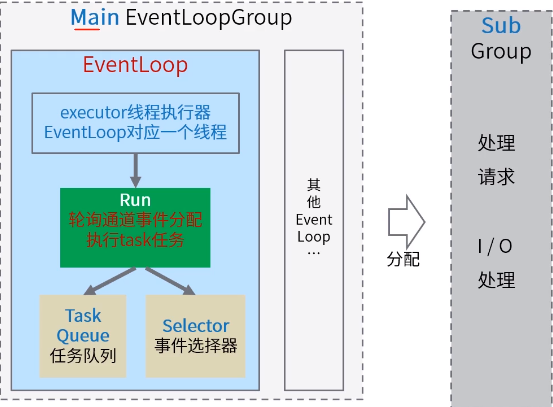
两组EventLoopGroup(Main&Sub)处理不同通道不同的事件
public final classEchoServer { static final int PORT = Integer.parseInt(System.getProperty("port", "8007")); public static void main(String[] args) throwsException { //Configure the server.
// 创建EventLoopGroup accept线程组 NioEventLoop
EventLoopGroup bossGroup = new NioEventLoopGroup(1);
// 创建EventLoopGroup I/O线程组 EventLoopGroup workerGroup = newNioEventLoopGroup(); final EchoServerHandler serverHandler = newEchoServerHandler(); try{
// 服务端启动引导工具类 ServerBootstrap b = newServerBootstrap();
// 配置服务端处理的reactor线程组以及服务端的其他配置 b.group(bossGroup, workerGroup2) .channel(NioServerSocketChannel.class) .option(ChannelOption.SO_BACKLOG, 100) .handler(newLoggingHandler(LogLevel.DEBUG)) .childHandler((ChannelInitializer)(ch)-> { ChannelPipeline p = ch.pipeline(); p.addLast(new EchoServerHandler); }); //通过bind启动服务器 ChannelFuture f =b.bind(PORT).sync(); //阻塞主线程,直到网络服务被关闭 f.channel().closeFuture().sync(); } finally{ //关闭线程组 bossGroup.shutdownGracefully(); workerGroup.shutdownGracefully(); } } }
EventLoopGroup bossGroup = new NioEventLoopGroup(1);
追踪NioEventLoopGroup源码,会发现是创造很多NioEventLoop
public class NioEventLoopGroup extendsMultithreadEventLoopGroup { ... public NioEventLoopGroup(intnThreads) { this(nThreads, (Executor) null); } ...
追踪到父类
public abstract class MultithreadEventLoopGroup extends MultithreadEventExecutorGroup implementsEventLoopGroup { private static final InternalLogger logger = InternalLoggerFactory.getInstance(MultithreadEventLoopGroup.class); private static final intDEFAULT_EVENT_LOOP_THREADS; static{ DEFAULT_EVENT_LOOP_THREADS = Math.max(1, SystemPropertyUtil.getInt( "io.netty.eventLoopThreads", NettyRuntime.availableProcessors() * 2)); if(logger.isDebugEnabled()) { logger.debug("-Dio.netty.eventLoopThreads: {}", DEFAULT_EVENT_LOOP_THREADS); } } /*** @seeMultithreadEventExecutorGroup#MultithreadEventExecutorGroup(int, Executor, Object...) */ protected MultithreadEventLoopGroup(intnThreads, Executor executor, Object... args) { super(nThreads == 0 ?DEFAULT_EVENT_LOOP_THREADS : nThreads, executor, args); // 默认是cpu核数*2 }
...
追踪父类
public abstract class MultithreadEventExecutorGroup extendsAbstractEventExecutorGroup { // 代码省略 //多线程的事件执行器 protected MultithreadEventExecutorGroup(intnThreads, Executor executor, EventExecutorChooserFactory chooserFactory, Object... args) { if (nThreads <= 0) { throw new IllegalArgumentException(String.format("nThreads: %d (expected: > 0)", nThreads)); } if (executor == null) {//Tony: 如果执行器为空,则创建一个
// EventLoop都是通过executor创建线程并执行它的 executor = newThreadPerTaskExecutor(newDefaultThreadFactory()); // 线程创建器,源码见下面 } // EventLoop是EventExecutor接口的具体实现 children = newEventExecutor[nThreads]; for (int i = 0; i < nThreads; i ++) { boolean success = false; try{
// 有多个实现方法,见下面 返回NioEventLoop children[i] =newChild(executor, args); success = true; } catch(Exception e) { //TODO: Think about if this is a good exception type throw new IllegalStateException("failed to create a child event loop", e); } finally{ if (!success) { for (int j = 0; j < i; j ++) { children[j].shutdownGracefully(); } for (int j = 0; j < i; j ++) { EventExecutor e =children[j]; try{ while (!e.isTerminated()) { e.awaitTermination(Integer.MAX_VALUE, TimeUnit.SECONDS); } } catch(InterruptedException interrupted) { //Let the caller handle the interruption. Thread.currentThread().interrupt(); break; } } } } } chooser =chooserFactory.newChooser(children); final FutureListener<Object> terminationListener = new FutureListener<Object>() { @Override public void operationComplete(Future<Object> future) throwsException { if (terminatedChildren.incrementAndGet() ==children.length) { terminationFuture.setSuccess(null); } } }; for(EventExecutor e: children) { e.terminationFuture().addListener(terminationListener); } Set<EventExecutor> childrenSet = new LinkedHashSet<EventExecutor>(children.length); Collections.addAll(childrenSet, children); readonlyChildren =Collections.unmodifiableSet(childrenSet); }
ThreadPerTaskExecutor创建线程
public final class ThreadPerTaskExecutor implementsExecutor { private finalThreadFactory threadFactory; publicThreadPerTaskExecutor(ThreadFactory threadFactory) { if (threadFactory == null) { throw new NullPointerException("threadFactory"); } this.threadFactory =threadFactory; } @Override public voidexecute(Runnable command) { threadFactory.newThread(command).start(); } }

NioEventLoopGroup
public class NioEventLoopGroup extendsMultithreadEventLoopGroup { //省略代码 @Override protected EventLoop newChild(Executor executor, Object... args) throwsException { return new NioEventLoop(this, executor, (SelectorProvider) args[0], ((SelectStrategyFactory) args[1]).newSelectStrategy(), (RejectedExecutionHandler) args[2]); } }
返回NioEventLoop,也传入了executor,用来帮助创建线程执行任务
看NioEventLoop的具体实现
public final class NioEventLoop extendsSingleThreadEventLoop { //代码省略 NioEventLoop(NioEventLoopGroup parent, Executor executor, SelectorProvider selectorProvider, SelectStrategy strategy, RejectedExecutionHandler rejectedExecutionHandler) { super(parent, executor, false, DEFAULT_MAX_PENDING_TASKS, rejectedExecutionHandler); if (selectorProvider == null) { throw new NullPointerException("selectorProvider"); } if (strategy == null) { throw new NullPointerException("selectStrategy"); } provider =selectorProvider; final SelectorTuple selectorTuple =openSelector(); selector =selectorTuple.selector; unwrappedSelector =selectorTuple.unwrappedSelector; selectStrategy =strategy; }
// 代码省略
selector是NIO的selector
NioEventLoop将通道注册到EventLoop的selector上,进行事件轮询
不断追踪NioEventLoop
最顶层是
public interfaceExecutor { /*** Executes the given command at some time in the future. The command * may execute in a new thread, in a pooled thread, or in the calling * thread, at the discretion of the {@codeExecutor} implementation. * * @paramcommand the runnable task * @throwsRejectedExecutionException if this task cannot be * accepted for execution * @throwsNullPointerException if command is null */ voidexecute(Runnable command); }
execute由SingleThreadEventExecutor实现
提交任务
public abstract class SingleThreadEventExecutor extends AbstractScheduledEventExecutor implementsOrderedEventExecutor { //省略代码 @Override public voidexecute(Runnable task) { if (task == null) { throw new NullPointerException("task"); } //判断execute方法的调用者是不是EventLoop同一个线程 boolean inEventLoop =inEventLoop(); addTask(task);//增加到任务队列 if (!inEventLoop) {//不是同一个线程,则调用启动方法 startThread(); if(isShutdown()) { boolean reject = false; try{ if(removeTask(task)) { reject = true; } } catch(UnsupportedOperationException e) { //The task queue does not support removal so the best thing we can do is to just move on and //hope we will be able to pick-up the task before its completely terminated. //In worst case we will log on termination. } if(reject) { reject(); } } } if (!addTaskWakesUp &&wakesUpForTask(task)) { wakeup(inEventLoop); } }
startThread
private voidstartThread() { if (state ==ST_NOT_STARTED) { if (STATE_UPDATER.compareAndSet(this, ST_NOT_STARTED, ST_STARTED)) { try{ doStartThread();//Tony: 未启动,则触发启动 } catch(Throwable cause) { STATE_UPDATER.set(this, ST_NOT_STARTED); PlatformDependent.throwException(cause); } } } } private voiddoStartThread() { assert thread == null; executor.execute(new Runnable() {//这里的executor是初始化EventLoop的时候传进来的 @Override public voidrun() { thread =Thread.currentThread(); if(interrupted) { thread.interrupt(); } boolean success = false; updateLastExecutionTime(); try {//创建线程开始执行run方法,所以,每个EventLoop都是执行run SingleThreadEventExecutor.this.run(); success = true; } catch(Throwable t) { logger.warn("Unexpected exception from an event executor: ", t); } finally{ for(;;) { int oldState =state; if (oldState >= ST_SHUTTING_DOWN ||STATE_UPDATER.compareAndSet( SingleThreadEventExecutor.this, oldState, ST_SHUTTING_DOWN)) { break; } } //Check if confirmShutdown() was called at the end of the loop. if (success && gracefulShutdownStartTime == 0) { if(logger.isErrorEnabled()) { logger.error("Buggy " + EventExecutor.class.getSimpleName() + " implementation; " +SingleThreadEventExecutor.class.getSimpleName() + ".confirmShutdown() must " + "be called before run() implementation terminates."); } } try{ //Run all remaining tasks and shutdown hooks. for(;;) { if(confirmShutdown()) { break; } } } finally{ try{ cleanup(); } finally{ STATE_UPDATER.set(SingleThreadEventExecutor.this, ST_TERMINATED); threadLock.release(); if (!taskQueue.isEmpty()) { if(logger.isWarnEnabled()) { logger.warn("An event executor terminated with " + "non-empty task queue (" + taskQueue.size() + ')'); } } terminationFuture.setSuccess(null); } } } } }); }
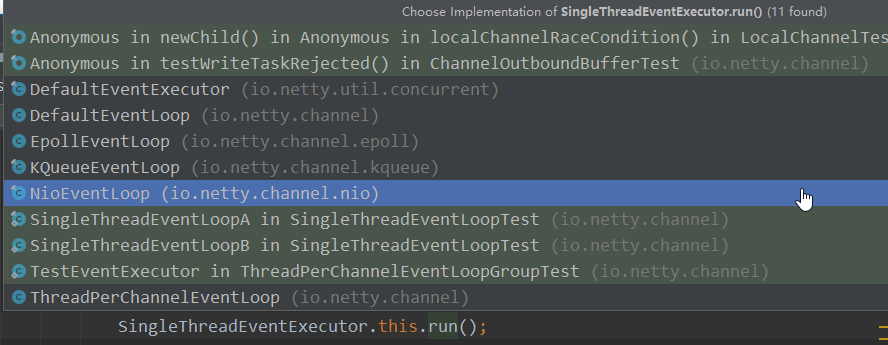
@Override protected void run() {//有任务提交后,被触发执行 for (;;) {//执行两件事selector,select的事件 和 taskQueue里面的内容 try{ try{ switch(selectStrategy.calculateStrategy(selectNowSupplier, hasTasks())) { caseSelectStrategy.CONTINUE: continue; caseSelectStrategy.BUSY_WAIT: //fall-through to SELECT since the busy-wait is not supported with NIO caseSelectStrategy.SELECT: select(wakenUp.getAndSet(false)); //'wakenUp.compareAndSet(false, true)' is always evaluated //before calling 'selector.wakeup()' to reduce the wake-up //overhead. (Selector.wakeup() is an expensive operation.) // //However, there is a race condition in this approach. //The race condition is triggered when 'wakenUp' is set to //true too early. // //'wakenUp' is set to true too early if: //1) Selector is waken up between 'wakenUp.set(false)' and //'selector.select(...)'. (BAD) //2) Selector is waken up between 'selector.select(...)' and //'if (wakenUp.get()) { ... }'. (OK) // //In the first case, 'wakenUp' is set to true and the //following 'selector.select(...)' will wake up immediately. //Until 'wakenUp' is set to false again in the next round, //'wakenUp.compareAndSet(false, true)' will fail, and therefore //any attempt to wake up the Selector will fail, too, causing //the following 'selector.select(...)' call to block //unnecessarily. // //To fix this problem, we wake up the selector again if wakenUp //is true immediately after selector.select(...). //It is inefficient in that it wakes up the selector for both //the first case (BAD - wake-up required) and the second case //(OK - no wake-up required). if(wakenUp.get()) { selector.wakeup(); } //fall through default: } } catch(IOException e) { //If we receive an IOException here its because the Selector is messed up. Let's rebuild //the selector and retry. https://github.com/netty/netty/issues/8566 rebuildSelector0(); handleLoopException(e); continue; } cancelledKeys = 0; needsToSelectAgain = false; final int ioRatio = this.ioRatio; if (ioRatio == 100) { try {//处理事件 processSelectedKeys(); } finally{ //Ensure we always run tasks. runAllTasks(); } } else{ final long ioStartTime =System.nanoTime(); try{ processSelectedKeys(); } finally{ //Ensure we always run tasks. final long ioTime = System.nanoTime() -ioStartTime; runAllTasks(ioTime * (100 - ioRatio) /ioRatio); } } } catch(Throwable t) { handleLoopException(t); } //Always handle shutdown even if the loop processing threw an exception. try{ if(isShuttingDown()) { closeAll(); if(confirmShutdown()) { return; } } } catch(Throwable t) { handleLoopException(t); } } } private static voidhandleLoopException(Throwable t) { logger.warn("Unexpected exception in the selector loop.", t); //Prevent possible consecutive immediate failures that lead to //excessive CPU consumption. try{ Thread.sleep(1000); } catch(InterruptedException e) { //Ignore. } } private voidprocessSelectedKeys() { if (selectedKeys != null) { processSelectedKeysOptimized(); } else {//处理事件 processSelectedKeysPlain(selector.selectedKeys()); } }
private void processSelectedKeysPlain(Set<SelectionKey>selectedKeys) { //check if the set is empty and if so just return to not create garbage by //creating a new Iterator every time even if there is nothing to process. //See https://github.com/netty/netty/issues/597 if(selectedKeys.isEmpty()) { return; } //获取selector所有选中的事件(ServerSocketChannel主要是OP_ACCEPT,SocketChannle主要是OP_READ) Iterator<SelectionKey> i =selectedKeys.iterator(); for(;;) { final SelectionKey k =i.next(); final Object a =k.attachment(); i.remove(); if (a instanceof AbstractNioChannel) {//处理niochannel事件 processSelectedKey(k, (AbstractNioChannel) a); } else{ @SuppressWarnings("unchecked") NioTask<SelectableChannel> task = (NioTask<SelectableChannel>) a; processSelectedKey(k, task); } if (!i.hasNext()) { break; } if(needsToSelectAgain) { selectAgain(); selectedKeys =selector.selectedKeys(); //Create the iterator again to avoid ConcurrentModificationException if(selectedKeys.isEmpty()) { break; } else{ i =selectedKeys.iterator(); } } } }
EventLoop自身实现了Executor接口,当调用executor方法提交任务时,则判断是否启动,未启动则调用内置的executor创建新线程来触发run方法执行
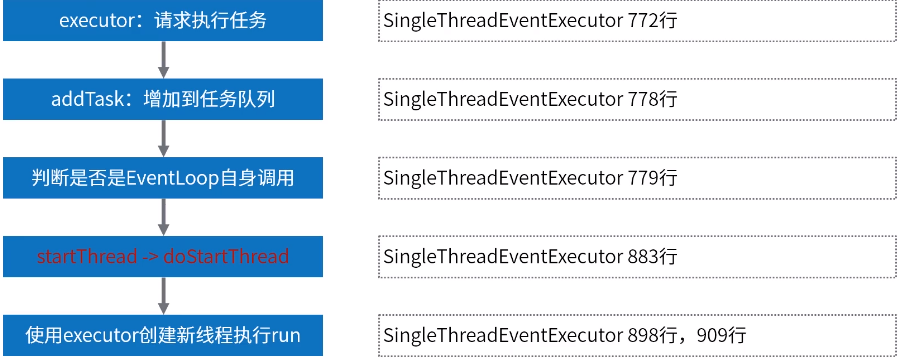
channel注册到selector上
请求
服务端启动的过程,服务端的启动就是Bind绑定端口的过程
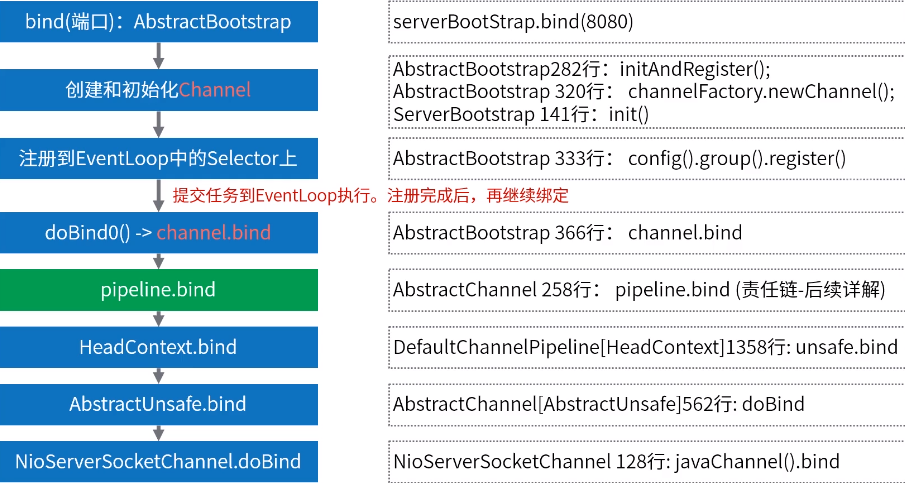
回到EchoServer
追踪bind源码
//Start the server. ChannelFuture f = b.bind(PORT).sync();
bind绑定端口并创建通道
public ChannelFuture bind(intinetPort) { return bind(new InetSocketAddress(inetPort)); //绑定端口的入口代码 } /*** Create a new {@linkChannel} and bind it. */ public ChannelFuture bind(String inetHost, intinetPort) { returnbind(SocketUtils.socketAddress(inetHost, inetPort)); } /*** Create a new {@linkChannel} and bind it. */ public ChannelFuture bind(InetAddress inetHost, intinetPort) { return bind(newInetSocketAddress(inetHost, inetPort)); } /*** Create a new {@linkChannel} and bind it. */ publicChannelFuture bind(SocketAddress localAddress) { validate(); if (localAddress == null) { throw new NullPointerException("localAddress"); } return doBind(localAddress);//真正干事的代码 } private ChannelFuture doBind(finalSocketAddress localAddress) { final ChannelFuture regFuture = initAndRegister();//创建/初始化ServerSocketChannel对象,并注册到Selector final Channel channel =regFuture.channel(); if (regFuture.cause() != null) { returnregFuture; } //等注册完成之后,再绑定端口。 防止端口开放了,却不能处理请求 if(regFuture.isDone()) { //At this point we know that the registration was complete and successful. ChannelPromise promise =channel.newPromise(); doBind0(regFuture, channel, localAddress, promise);//实际操作绑定端口的代码 returnpromise; } else{ //Registration future is almost always fulfilled already, but just in case it's not. final PendingRegistrationPromise promise = newPendingRegistrationPromise(channel); regFuture.addListener(newChannelFutureListener() { @Override public void operationComplete(ChannelFuture future) throwsException { Throwable cause =future.cause(); if (cause != null) { //Registration on the EventLoop failed so fail the ChannelPromise directly to not cause an //IllegalStateException once we try to access the EventLoop of the Channel. promise.setFailure(cause); } else{ //Registration was successful, so set the correct executor to use. //See https://github.com/netty/netty/issues/2586 promise.registered(); doBind0(regFuture, channel, localAddress, promise); } } }); returnpromise; } } finalChannelFutureinitAndRegister() { Channel channel = null; try{ channel =channelFactory.newChannel(); // 通道 init(channel); // 初始化通道 } catch(Throwable t) { if (channel != null) { //channel can be null if newChannel crashed (eg SocketException("too many open files")) channel.unsafe().closeForcibly(); //as the Channel is not registered yet we need to force the usage of the GlobalEventExecutor return newDefaultChannelPromise(channel, GlobalEventExecutor.INSTANCE).setFailure(t); } //as the Channel is not registered yet we need to force the usage of the GlobalEventExecutor return new DefaultChannelPromise(newFailedChannel(), GlobalEventExecutor.INSTANCE).setFailure(t); } //(一开始初始化的group)MultithreadEventLoopGroup里面选择一个eventLoop进行绑定 ChannelFuture regFuture =config().group().register(channel); // register见下面 if (regFuture.cause() != null) { if(channel.isRegistered()) { channel.close(); } else{ channel.unsafe().closeForcibly(); } } //If we are here and the promise is not failed, it's one of the following cases: //1) If we attempted registration from the event loop, the registration has been completed at this point. //i.e. It's safe to attempt bind() or connect() now because the channel has been registered. //2) If we attempted registration from the other thread, the registration request has been successfully //added to the event loop's task queue for later execution. //i.e. It's safe to attempt bind() or connect() now: //because bind() or connect() will be executed *after* the scheduled registration task is executed //because register(), bind(), and connect() are all bound to the same thread. returnregFuture; } abstract void init(Channel channel) throwsException; private static voiddoBind0( final ChannelFuture regFuture, finalChannel channel, final SocketAddress localAddress, finalChannelPromise promise) { //This method is invoked before channelRegistered() is triggered. Give user handlers a chance to set up //the pipeline in its channelRegistered() implementation. channel.eventLoop().execute(newRunnable() { @Override public void run() {//这里向EventLoop提交任务,一旦有任务提交则会触发EventLoop的轮询 if (regFuture.isSuccess()) {//本质又绕回到channel的bind方法上面。 channel.bind(localAddress, promise).addListener(ChannelFutureListener.CLOSE_ON_FAILURE); } else{ promise.setFailure(regFuture.cause()); } } }); }
@Override publicChannelFuture register(Channel channel){ return next().register(channel); //根据选择器,选择一个合适的NioEventLoop进行注册(SingleEventLoop) }
追踪register代码...
netty中的Channel是一个抽象的概念,可以理解为对JDK NIO Channel的增强和拓展。增加了很多属性和方法,下面罗列几个常见的属性和方法:
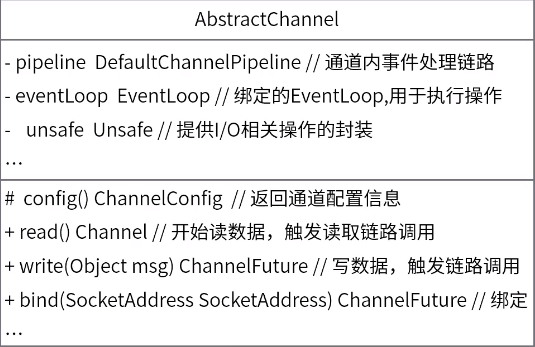
三、责任链设计模式
责任链(Chain of Responsibility Pattern)为请求创建了一个处理对象的链。
发起请求和具体处理请求的过程进行解耦:职责链上的处理者负责处理请求,客户只需要将请求发送到职责链上即可,无须关心请求的处理细节和请求的传递。

handler是具体处理请求的程序
实现责任链模式4个要素:处理器抽象类、具体的处理器实现类、保存处理器信息、处理执行


责任链代码示例
//-----链表形式调用------netty就是类似的这种形式 public classPipelineDemo { /*** 初始化的时候造一个head,作为责任链的开始,但是并没有具体的处理 */ public HandlerChainContext head = new HandlerChainContext(newAbstractHandler() { @Override voiddoHandler(HandlerChainContext handlerChainContext, Object arg0) { handlerChainContext.runNext(arg0); } }); public voidrequestProcess(Object arg0) { this.head.handler(arg0); } public voidaddLast(AbstractHandler handler) { HandlerChainContext context =head; while (context.next != null) { context =context.next; } context.next = newHandlerChainContext(handler); } public static voidmain(String[] args) { PipelineDemo pipelineChainDemo = newPipelineDemo(); pipelineChainDemo.addLast(newHandler2()); pipelineChainDemo.addLast(newHandler1()); pipelineChainDemo.addLast(newHandler1()); pipelineChainDemo.addLast(newHandler2()); //发起请求 pipelineChainDemo.requestProcess("火车呜呜呜~~"); } } /*** handler上下文,我主要负责维护链,和链的执行 */ classHandlerChainContext { HandlerChainContext next; //下一个节点 AbstractHandler handler; publicHandlerChainContext(AbstractHandler handler) { this.handler =handler; } voidhandler(Object arg0) { this.handler.doHandler(this, arg0); } /*** 继续执行下一个 */ voidrunNext(Object arg0) { if (this.next != null) { this.next.handler(arg0); } } } //处理器抽象类 abstract classAbstractHandler { /*** 处理器,这个处理器就做一件事情,在传入的字符串中增加一个尾巴.. */ abstract void doHandler(HandlerChainContext handlerChainContext, Object arg0); //handler方法 } //处理器具体实现类 class Handler1 extendsAbstractHandler { @Override voiddoHandler(HandlerChainContext handlerChainContext, Object arg0) { arg0 = arg0.toString() + "..handler1的小尾巴....."; System.out.println("我是Handler1的实例,我在处理:" +arg0); //继续执行下一个 handlerChainContext.runNext(arg0); } } //处理器具体实现类 class Handler2 extendsAbstractHandler { @Override voiddoHandler(HandlerChainContext handlerChainContext, Object arg0) { arg0 = arg0.toString() + "..handler2的小尾巴....."; System.out.println("我是Handler2的实例,我在处理:" +arg0); //继续执行下一个 handlerChainContext.runNext(arg0); } }
Netty中的ChannelPipeline责任链
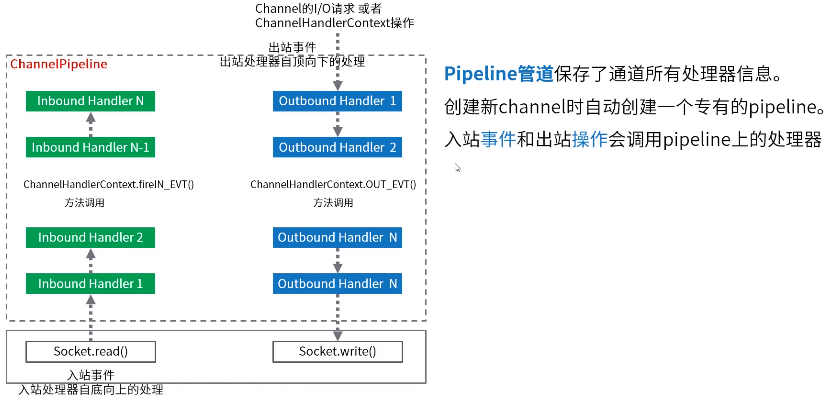
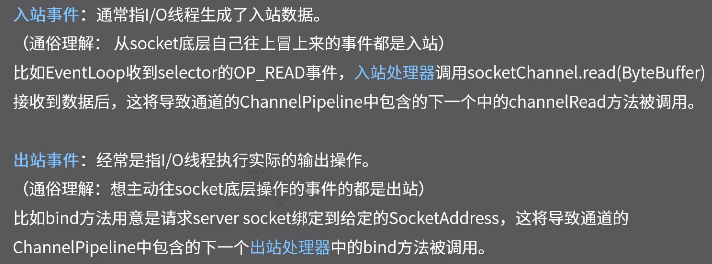
Nettty中定义了很多事件
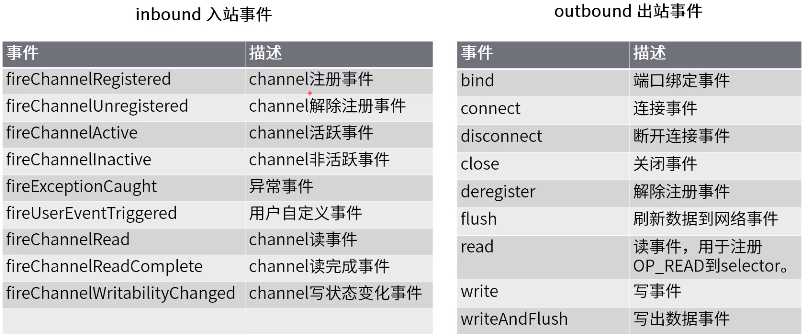
Pipeline中的handler是什么?
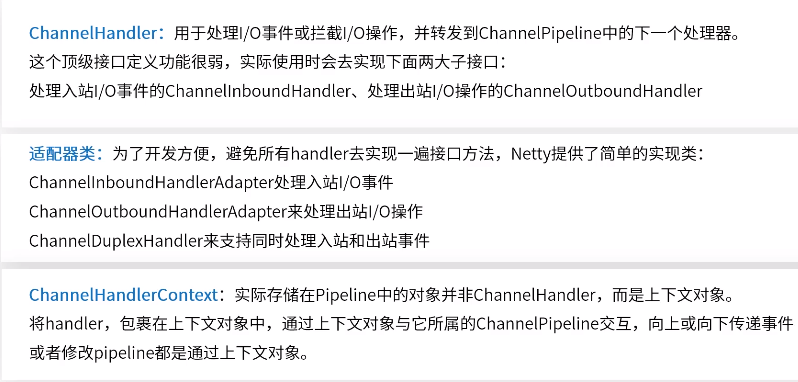
ChannelPipeline是线程安全的,ChannelHandler可以在任何时候添加或删除。
例如,可以在即将交换敏感信息时插入加密处理程序,并在交换后删除。
一般操作,初始化的时候增加进去,较少删除。下面是Pipeline中管理handler的API:

源码查看
handler执行分析
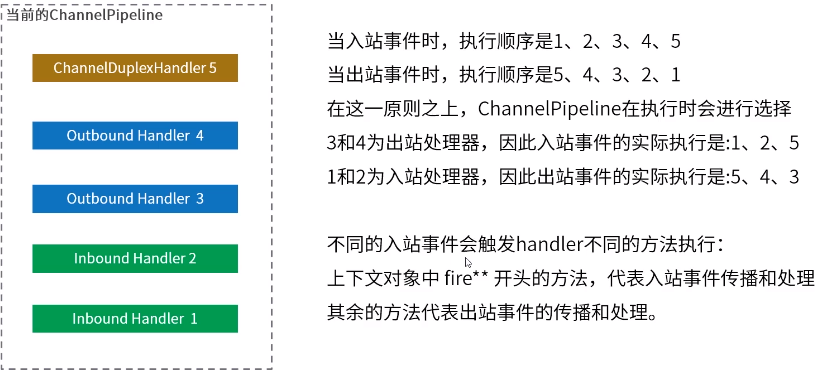
分析registered入站事件的处理

源码查看 从bind()进入

bind出站事件分析
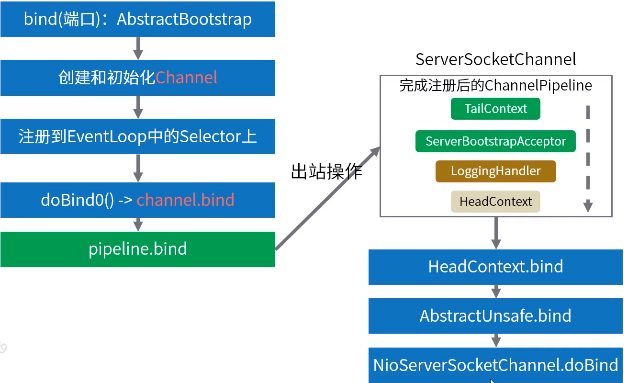
源码查看
分析accept入站事件的处理
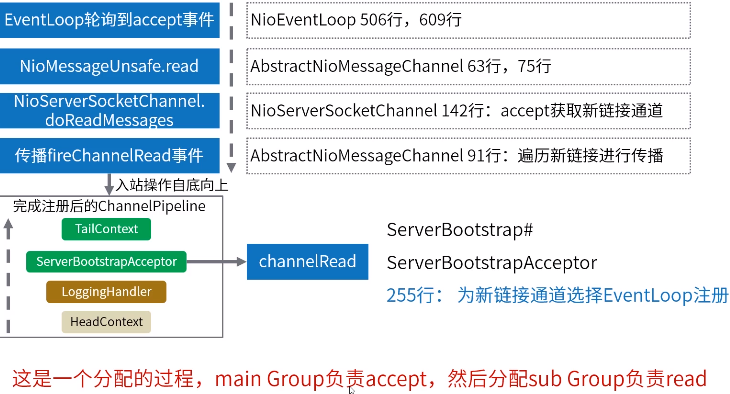
源码查看
read入站事件的处理
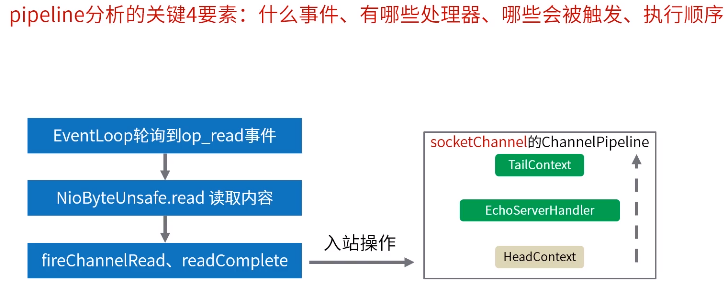
源码查看

四、零拷贝机制
JDK ByteBuffer存在一些缺点:
- 无法动态扩容。长度是固定的,不能动态扩展和收缩,当数据大于ByteBuffer容量时,会发生索引越界异常。
- API使用复杂。读写的时候需要手工调用flip()和rewind()等方法,使用时需要非常谨慎的使用这些api,否则容易出错。
1.Netty自己的ByteBuf
ByteBuf是为解决ByteBuffer的问题和满足网络应用程序开发人员的日常需求而设计的。
ByteBuf的增强:
- API操作便捷性
- 动态扩容
- 多种ByteBuf实现
- 高效的零拷贝机制
2.ByteBuf操作
ByteBuf三个重要属性:capacity容量、readerIndex读取位置、writeIndex写入位置。
提供了两个指针变量来支持顺序读和写操作,分别时readerIndex和写操作writeIndex
常用方法定义:
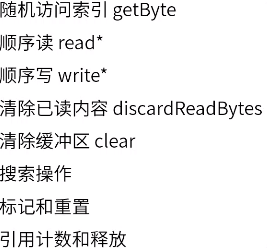
下图显示了一个缓冲区是如何被两个指针分割成三个区域的:

示例代码
/*** bytebuf的常规API操作示例 */ public classByteBufDemo { @Test public voidapiTest() { //+-------------------+------------------+------------------+ //| discardable bytes | readable bytes | writable bytes | //| | (CONTENT) | | //+-------------------+------------------+------------------+ //| | | | //0 <= readerIndex <= writerIndex <= capacity //1.创建一个非池化的ByteBuf,大小为10个字节 ByteBuf buf = Unpooled.buffer(10); System.out.println("原始ByteBuf为====================>" +buf.toString()); System.out.println("1.ByteBuf中的内容为===============>" + Arrays.toString(buf.array()) + " "); //2.写入一段内容 byte[] bytes = {1, 2, 3, 4, 5}; buf.writeBytes(bytes); System.out.println("写入的bytes为====================>" +Arrays.toString(bytes)); System.out.println("写入一段内容后ByteBuf为===========>" +buf.toString()); System.out.println("2.ByteBuf中的内容为===============>" + Arrays.toString(buf.array()) + " "); //3.读取一段内容 byte b1 =buf.readByte(); byte b2 =buf.readByte(); System.out.println("读取的bytes为====================>" + Arrays.toString(new byte[]{b1, b2})); System.out.println("读取一段内容后ByteBuf为===========>" +buf.toString()); System.out.println("3.ByteBuf中的内容为===============>" + Arrays.toString(buf.array()) + " "); //4.将读取的内容丢弃 buf.discardReadBytes(); System.out.println("将读取的内容丢弃后ByteBuf为========>" +buf.toString()); System.out.println("4.ByteBuf中的内容为===============>" + Arrays.toString(buf.array()) + " "); //5.清空读写指针 buf.clear(); System.out.println("将读写指针清空后ByteBuf为==========>" +buf.toString()); System.out.println("5.ByteBuf中的内容为===============>" + Arrays.toString(buf.array()) + " "); //6.再次写入一段内容,比第一段内容少 byte[] bytes2 = {1, 2, 3}; buf.writeBytes(bytes2); System.out.println("写入的bytes为====================>" +Arrays.toString(bytes2)); System.out.println("写入一段内容后ByteBuf为===========>" +buf.toString()); System.out.println("6.ByteBuf中的内容为===============>" + Arrays.toString(buf.array()) + " "); //7.将ByteBuf清零 buf.setZero(0, buf.capacity()); System.out.println("将内容清零后ByteBuf为==============>" +buf.toString()); System.out.println("7.ByteBuf中的内容为================>" + Arrays.toString(buf.array()) + " "); //8.再次写入一段超过容量的内容 byte[] bytes3 = {1, 2, 3, 4, 5, 6, 7, 8, 9, 10, 11}; buf.writeBytes(bytes3); System.out.println("写入的bytes为====================>" +Arrays.toString(bytes3)); System.out.println("写入一段内容后ByteBuf为===========>" +buf.toString()); System.out.println("8.ByteBuf中的内容为===============>" + Arrays.toString(buf.array()) + " "); //随机访问索引 getByte //顺序读 read* //顺序写 write* //清除已读内容 discardReadBytes //清除缓冲区 clear //搜索操作 //标记和重置 //完整代码示例:参考 //搜索操作 读取指定位置 buf.getByte(1); // } }
Unpooled推荐的方式创建buf
可以动态扩容
运行结果
原始ByteBuf为====================>UnpooledByteBufAllocator$InstrumentedUnpooledUnsafeHeapByteBuf(ridx: 0, widx: 0, cap: 10) 1.ByteBuf中的内容为===============>[0, 0, 0, 0, 0, 0, 0, 0, 0, 0] 写入的bytes为====================>[1, 2, 3, 4, 5] 写入一段内容后ByteBuf为===========>UnpooledByteBufAllocator$InstrumentedUnpooledUnsafeHeapByteBuf(ridx: 0, widx: 5, cap: 10) 2.ByteBuf中的内容为===============>[1, 2, 3, 4, 5, 0, 0, 0, 0, 0] 读取的bytes为====================>[1, 2] 读取一段内容后ByteBuf为===========>UnpooledByteBufAllocator$InstrumentedUnpooledUnsafeHeapByteBuf(ridx: 2, widx: 5, cap: 10) 3.ByteBuf中的内容为===============>[1, 2, 3, 4, 5, 0, 0, 0, 0, 0] 将读取的内容丢弃后ByteBuf为========>UnpooledByteBufAllocator$InstrumentedUnpooledUnsafeHeapByteBuf(ridx: 0, widx: 3, cap: 10) 4.ByteBuf中的内容为===============>[3, 4, 5, 4, 5, 0, 0, 0, 0, 0] 将读写指针清空后ByteBuf为==========>UnpooledByteBufAllocator$InstrumentedUnpooledUnsafeHeapByteBuf(ridx: 0, widx: 0, cap: 10) 5.ByteBuf中的内容为===============>[3, 4, 5, 4, 5, 0, 0, 0, 0, 0] 写入的bytes为====================>[1, 2, 3] 写入一段内容后ByteBuf为===========>UnpooledByteBufAllocator$InstrumentedUnpooledUnsafeHeapByteBuf(ridx: 0, widx: 3, cap: 10) 6.ByteBuf中的内容为===============>[1, 2, 3, 4, 5, 0, 0, 0, 0, 0] 将内容清零后ByteBuf为==============>UnpooledByteBufAllocator$InstrumentedUnpooledUnsafeHeapByteBuf(ridx: 0, widx: 3, cap: 10) 7.ByteBuf中的内容为================>[0, 0, 0, 0, 0, 0, 0, 0, 0, 0] 写入的bytes为====================>[1, 2, 3, 4, 5, 6, 7, 8, 9, 10, 11] 写入一段内容后ByteBuf为===========>UnpooledByteBufAllocator$InstrumentedUnpooledUnsafeHeapByteBuf(ridx: 0, widx: 14, cap: 64) 8.ByteBuf中的内容为===============>[0, 0, 0, 1, 2, 3, 4, 5, 6, 7, 8, 9, 10, 11, 0, 0, 0, 0, 0, 0, 0, 0, 0, 0, 0, 0, 0, 0, 0, 0, 0, 0, 0, 0, 0, 0, 0, 0, 0, 0, 0, 0, 0, 0, 0, 0, 0, 0, 0, 0, 0, 0, 0, 0, 0, 0, 0, 0, 0, 0, 0, 0, 0, 0]
动态扩容
io.netty.buffer.AbstractByteBuf下:
final void ensureWritable0(intminWritableBytes) { ensureAccessible(); if (minWritableBytes <=writableBytes()) { return; } final int writerIndex =writerIndex(); if(checkBounds) { if (minWritableBytes > maxCapacity -writerIndex) { throw newIndexOutOfBoundsException(String.format( "writerIndex(%d) + minWritableBytes(%d) exceeds maxCapacity(%d): %s", writerIndex, minWritableBytes, maxCapacity, this)); } } //Normalize the current capacity to the power of 2. int minNewCapacity = writerIndex +minWritableBytes; int newCapacity =alloc().calculateNewCapacity(minNewCapacity, maxCapacity); int fastCapacity = writerIndex +maxFastWritableBytes(); //Grow by a smaller amount if it will avoid reallocation if (newCapacity > fastCapacity && minNewCapacity <=fastCapacity) { newCapacity =fastCapacity; } //Adjust to the new capacity. capacity(newCapacity); }
calculateNewCapacity
@Override public int calculateNewCapacity(int minNewCapacity, intmaxCapacity) { // minNewCapacity:14 maxCapacity:2147483647 checkPositiveOrZero(minNewCapacity, "minNewCapacity"); if (minNewCapacity >maxCapacity) { // minCapacity:14 throw newIllegalArgumentException(String.format( "minNewCapacity: %d (expected: not greater than maxCapacity(%d)", minNewCapacity, maxCapacity)); } // 阈值4M,这个阈值的用意:容量要求4M以内,每次扩容以2的倍数进行计算,超过4M容量,另外的计算方式。 final int threshold = CALCULATE_THRESHOLD; //4 MiB page if (minNewCapacity ==threshold) { // 新容量的最小要求,如果等于阈值,则立刻返回 returnthreshold; } //If over threshold, do not double but just increase by threshold. if (minNewCapacity >threshold) { int newCapacity = minNewCapacity / threshold *threshold; if (newCapacity > maxCapacity -threshold) { newCapacity =maxCapacity; } else{ newCapacity +=threshold; } returnnewCapacity; } // 如果容量要求没超过阈值,则从64字节开始,不断增加一倍,直至满足新容量最小要求 //Not over threshold. Double up to 4 MiB, starting from 64. int newCapacity = 64; while (newCapacity <minNewCapacity) { newCapacity <<= 1; } returnMath.min(newCapacity, maxCapacity); }
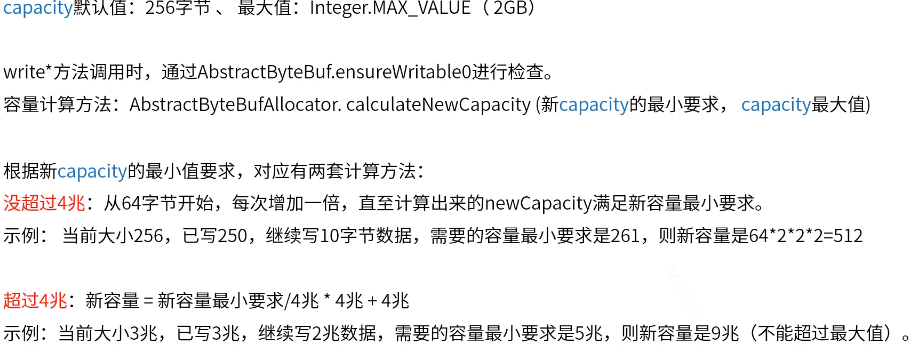

选择合适的ByteBuf实现:
了解核心的3个维度的划分方式,8种具体实现

在使用中,都是使用ByteBufAllocator分配器进行申请,同时分配器具有内存管理的功能
堆外内存示例
/*** 堆外内存的常规API操作示例 */ public classDirectByteBufDemo { @Test public voidapiTest() { //+-------------------+------------------+------------------+ //| discardable bytes | readable bytes | writable bytes | //| | (CONTENT) | | //+-------------------+------------------+------------------+ //| | | | //0 <= readerIndex <= writerIndex <= capacity //1.创建一个非池化的ByteBuf,大小为10个字节 ByteBuf buf = Unpooled.directBuffer(10); System.out.println("原始ByteBuf为====================>" +buf.toString()); //System.out.println("1.ByteBuf中的内容为===============>" + Arrays.toString(buf.array()) + " "); 堆外内存不能用buf.array() //2.写入一段内容 byte[] bytes = {1, 2, 3, 4, 5}; buf.writeBytes(bytes); System.out.println("写入的bytes为====================>" +Arrays.toString(bytes)); System.out.println("写入一段内容后ByteBuf为===========>" +buf.toString()); //System.out.println("2.ByteBuf中的内容为===============>" + Arrays.toString(buf.array()) + " "); //3.读取一段内容 byte b1 =buf.readByte(); byte b2 =buf.readByte(); System.out.println("读取的bytes为====================>" + Arrays.toString(new byte[]{b1, b2})); System.out.println("读取一段内容后ByteBuf为===========>" +buf.toString()); //System.out.println("3.ByteBuf中的内容为===============>" + Arrays.toString(buf.array()) + " "); //4.将读取的内容丢弃 buf.discardReadBytes(); System.out.println("将读取的内容丢弃后ByteBuf为========>" +buf.toString()); //System.out.println("4.ByteBuf中的内容为===============>" + Arrays.toString(buf.array()) + " "); //5.清空读写指针 buf.clear(); System.out.println("将读写指针清空后ByteBuf为==========>" +buf.toString()); //System.out.println("5.ByteBuf中的内容为===============>" + Arrays.toString(buf.array()) + " "); //6.再次写入一段内容,比第一段内容少 byte[] bytes2 = {1, 2, 3}; buf.writeBytes(bytes2); System.out.println("写入的bytes为====================>" +Arrays.toString(bytes2)); System.out.println("写入一段内容后ByteBuf为===========>" +buf.toString()); //System.out.println("6.ByteBuf中的内容为===============>" + Arrays.toString(buf.array()) + " "); //7.将ByteBuf清零 buf.setZero(0, buf.capacity()); System.out.println("将内容清零后ByteBuf为==============>" +buf.toString()); //System.out.println("7.ByteBuf中的内容为================>" + Arrays.toString(buf.array()) + " "); //8.再次写入一段超过容量的内容 byte[] bytes3 = {1, 2, 3, 4, 5, 6, 7, 8, 9, 10, 11}; buf.writeBytes(bytes3); System.out.println("写入的bytes为====================>" +Arrays.toString(bytes3)); System.out.println("写入一段内容后ByteBuf为===========>" +buf.toString()); //System.out.println("8.ByteBuf中的内容为===============>" + Arrays.toString(buf.array()) + " "); //随机访问索引 getByte //顺序读 read* //顺序写 write* //清除已读内容 discardReadBytes //清除缓冲区 clear //搜索操作 //标记和重置 //完整代码示例:参考 //搜索操作 读取指定位置 buf.getByte(1); // } }
Unsafe的实现

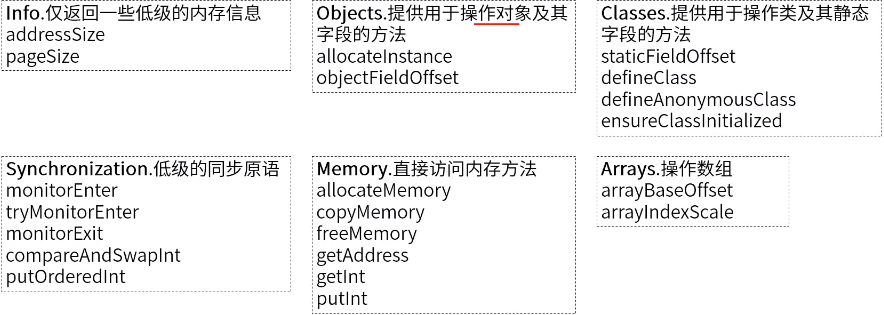
内存复用
PooledByteBuf对象、内存复用


3.零拷贝机制
Netty的零拷贝机制,是一种应用层的实现。和底层的JVM、操作系统内存机制并无过多关联。

代码示例
/*** 零拷贝示例 */ public classZeroCopyTest { @org.junit.Test public voidwrapTest() { byte[] arr = {1, 2, 3, 4, 5}; ByteBuf byteBuf =Unpooled.wrappedBuffer(arr); System.out.println(byteBuf.getByte(4)); arr[4] = 6; System.out.println(byteBuf.getByte(4)); } // java数组转为buf 5 arr修改为6后,byteBuf也变为6,说明两者用的是相同的数据,零拷贝 @org.junit.Test public voidsliceTest() { ByteBuf buffer1 = Unpooled.wrappedBuffer("hello".getBytes()); ByteBuf newBuffer = buffer1.slice(1, 2); newBuffer.unwrap(); System.out.println(newBuffer.toString()); } // 拆分。不会动原来的buf,还保留原来buf的地址 @org.junit.Test public voidcompositeTest() { ByteBuf buffer1 = Unpooled.buffer(3); buffer1.writeByte(1); ByteBuf buffer2 = Unpooled.buffer(3); buffer2.writeByte(4); CompositeByteBuf compositeByteBuf =Unpooled.compositeBuffer(); CompositeByteBuf newBuffer = compositeByteBuf.addComponents(true, buffer1, buffer2); System.out.println(newBuffer); } // 合并。还保留原来buf的信息 }